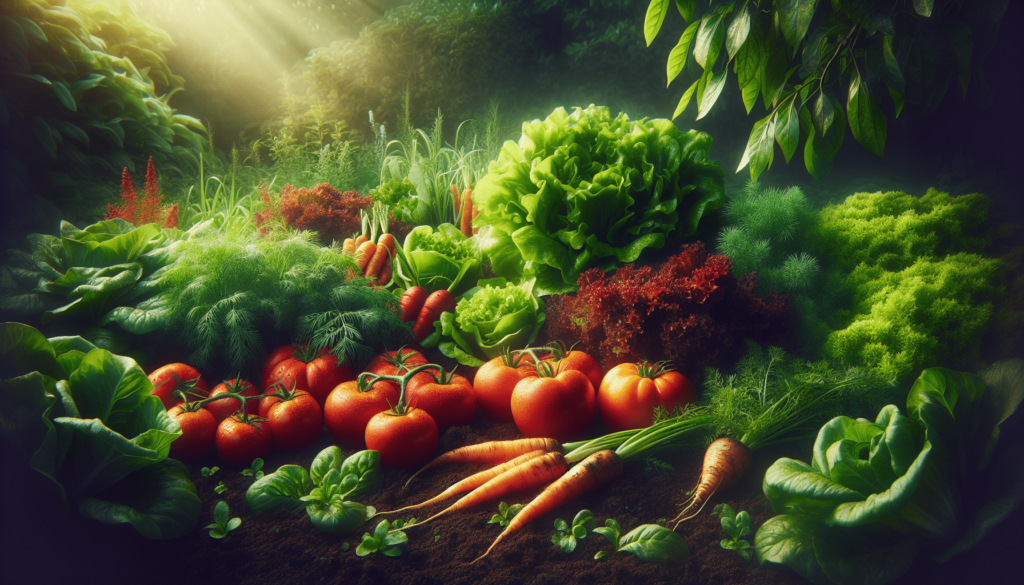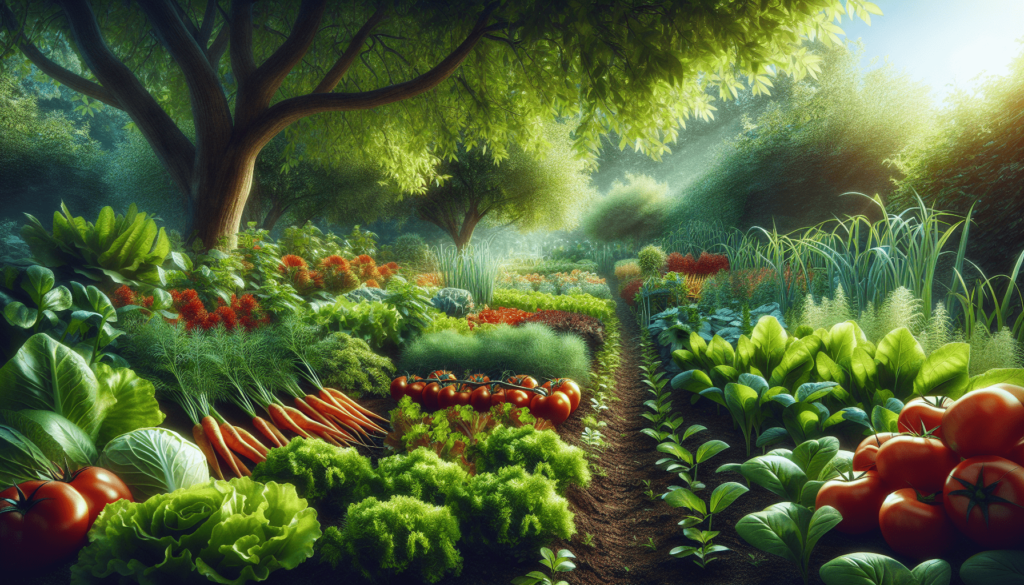
Welcome to “The Ultimate Guide to Organic Gardening”! In our journey through this guide, we’ll explore the secrets and techniques that transform our gardens into lush, vibrant, and eco-friendly havens. We’ll discover how to cultivate plants without relying on synthetic chemicals, enrich our soil naturally, and protect our precious pollinators. Together, we’ll embrace practices that nurture our earth and yield bountiful, healthful harvests that truly taste delicious. So, grab your gardening gloves, and let’s dig into the wonderful world of organic gardening! Have you ever wondered how to grow your own food without the use of synthetic pesticides or fertilizers? We certainly have, and that’s why we embarked on the journey of organic gardening! Whether you are a complete newbie or someone looking to refine your green thumb, this guide is tailored for you.
The Ultimate Guide to Organic Gardening
Organic gardening isn’t just about growing plants; it’s about cultivating a sustainable and harmonious environment. Engaging in organic gardening encourages us to form a deeper connection with nature and assures us of safer, healthier food options. Let’s delve into the nitty-gritty, shall we?

What is Organic Gardening?
Organic gardening involves growing plants without synthetic chemicals, relying instead on natural processes to nourish and protect. By using organic methods, we encourage biodiversity and create balanced ecosystems that are less prone to pest outbreaks and diseases.
Benefits of Organic Gardening
Organic gardening isn’t just a trend; it’s a lifestyle. Here are some of its top benefits:
- Healthier Produce: Organic fruits and vegetables are free from synthetic pesticides and fertilizers. They are generally richer in nutrients and antioxidants.
- Environmental Protection: Reduces groundwater contamination and encourages soil health.
- Biodiversity: Promotes a balanced ecosystem, attracting beneficial insects and birds.
- Sustainability: Conserves energy and resources, typically resulting in long-term benefits for our planet.
Choosing the Right Location
The success of your organic garden starts with selecting an ideal location. Let’s explore some factors that will help us choose wisely.
Sunlight
Most vegetable and fruit plants require at least 6-8 hours of sunlight per day. Observe the sunlight patterns in your yard to determine the sunniest spots.
Soil Quality
The foundation of organic gardening is healthy soil. A well-drained, fertile soil rich in organic matter is essential. Conduct a soil test to understand its pH and nutrient levels.
Water Availability
Access to a clean, consistent water supply is crucial. Consider the proximity to a water source and plan the layout of irrigation systems accordingly.
Preparing the Soil
Healthy soil is teeming with microorganisms that contribute to plant health. Preparing your soil might be one of the most essential steps.
Composting
Adding compost to soil enhances its structure, providing essential nutrients. Composting kitchen scraps, garden waste, and even paper products can create ‘black gold’ for our gardens.
Mulching
Mulching helps retain moisture, suppress weeds, and improves soil fertility as it decomposes. Organic mulches include straw, grass clippings, and wood chips.
Crop Rotation
Planting different crops in successive seasons prevents soil depletion and reduces pests and diseases. Consider rotating heavy feeders (like tomatoes) with light feeders (like lettuce).
Selecting Plants
Choosing the right plants can be overwhelming, but with a few guidelines, it becomes much more manageable.
Native and Heirloom Varieties
Opt for native plants, as they are adapted to local conditions and require less maintenance. Heirloom varieties are also excellent as they preserve biodiversity and offer unique flavors.
Companion Planting
Certain plants grow better together, while others should be kept apart. For instance, basil and tomatoes thrive together, whereas onions and beans do not. Here’s a quick reference table:
| Companion Plants | Benefits |
|---|---|
| Basil + Tomatoes | Improves flavor, repels pests |
| Beans + Corn | Provides nitrogen |
| Carrots + Onions | Repels onion and carrot flies |

Planting Techniques
There are several tried-and-true planting techniques that foster a healthy garden.
Starting Seeds Indoors
Starting seeds indoors allows us to extend our growing season. Use seed trays and a good potting mix to get started. Transplant seedlings outside 2-3 weeks after the last frost.
Direct Sowing
Some plants, like beans and carrots, do better when sown directly into the ground. Follow the spacing and depth recommendations on the seed packets.
Transplanting
When transplanting, ensure that seedlings are hardened off to acclimate them to outdoor conditions. Water them thoroughly before and after transplanting to reduce shock.
Maintenance and Care
Maintaining an organic garden requires consistent care and attention.
Watering
Watering deeply yet infrequently encourages strong root growth. We recommend watering early in the morning to minimize evaporation and prevent diseases.
Natural Pest Control
Nature provides plenty of allies to combat pests. Ladybugs, lacewings, and birds all play vital roles in keeping harmful insects in check. Grow flowers like marigolds and nasturtiums to attract beneficial insects.
Weeding
Regular weeding is crucial to prevent competition for nutrients. Mulching and crop rotation can reduce weed pressure.
Fertilizing Organically
Nutrient-rich soil is essential, and organic fertilizers are the best way to maintain soil health.
Types of Organic Fertilizers
Organic fertilizers can be sourced from plants, animals, or minerals. Here’s a simplified table for quick reference:
| Type of Fertilizer | Nutrient Content |
|---|---|
| Compost | Balanced nutrients |
| Bone Meal | High in phosphorus |
| Fish Emulsion | Rich in nitrogen |
| Green Manure (cover crops) | Adds organic matter, nitrogen |
| Rock Phosphate | Provides phosphorus |
Application Methods
Apply fertilizer based on the results of your soil test. Side-dressing, top-dressing, and foliar feeding are some common application methods. Always follow the recommended rates to avoid over-fertilization.
Extending the Growing Season
With a few techniques and tools, we can enjoy our organic garden’s bounty even in less favorable conditions.
Cold Frames and Row Covers
Cold frames and row covers provide extra warmth and protection from frost, extending the growing season by several weeks.
Greenhouses
Greenhouses allow us to control temperature, humidity, and light, making it possible to grow plants year-round.
Harvesting and Storing
There’s nothing quite like the taste of fresh, homegrown produce. Knowing when and how to harvest is key to maximizing flavor and nutrition.
Harvesting Techniques
Each type of produce has its own ideal harvesting technique. For example, beans should be picked when they are young and tender, whereas tomatoes should be left to ripen fully on the vine.
Storage Tips
Proper storage can extend the shelf life of your harvest. Root vegetables like carrots and potatoes store well in cool, dark, and humid conditions. Leafy greens should be consumed quickly or refrigerated to maintain freshness.
Troubleshooting Common Issues
Like everything in life, gardening comes with its challenges. Let’s tackle some common issues:
Pests
If pests are wreaking havoc on your garden, consider introducing beneficial insects, using natural repellents like neem oil, or creating barriers with row covers.
Diseases
Plant diseases can be minimized by practicing crop rotation, spacing plants to ensure good air circulation, and removing infected plant material promptly.
Nutrient Deficiencies
Yellowing leaves or stunted growth may indicate a nutrient deficiency. Conduct a soil test and amend with appropriate organic fertilizers.
Conclusion
Organic gardening is a rewarding endeavor that brings us closer to nature and provides us with healthier, more flavorful produce. By following the steps outlined in this guide, we can create a thriving organic garden that benefits us and the environment. Let’s roll up our sleeves and get our hands dirty—happy gardening!
As with any journey, the beginning may seem daunting, but with patience, attention, and a touch of organic magic, our garden will flourish. And remember, every seasoned gardener started as a novice, so don’t be afraid to experiment, learn, and grow along the way. Here’s to a bountiful harvest!





